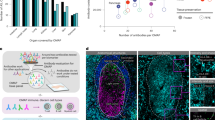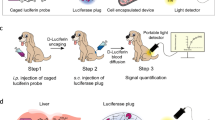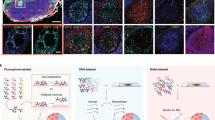Abstract
We describe a new methodology, based on terminal perfusion of rodents with a reactive ester derivative of biotin that enables the covalent modification of proteins readily accessible from the bloodstream. Biotinylated proteins from total organ extracts can be purified on streptavidin resin in the presence of strong detergents, digested on the resin and subjected to liquid chromatography–tandem mass spectrometry for identification. In the present study, in vivo biotinylation procedure led to the identification of hundreds of proteins in different mouse organs, including some showing a restricted pattern of expression in certain body tissues. Furthermore, biotinylation of mice with F9 subcutaneous tumors or orthotopic kidney tumors revealed both quantitative and qualitative differences in the recovery of biotinylated proteins, as compared to normal tissues. This technology is applicable to proteomic investigations of the differential expression of accessible proteins in physiological and pathological processes in animal models, and to human surgical specimens using ex vivo perfusion procedures.
This is a preview of subscription content, access via your institution
Access options
Subscribe to this journal
Receive 12 print issues and online access
$259.00 per year
only $21.58 per issue
Buy this article
- Purchase on Springer Link
- Instant access to full article PDF
Prices may be subject to local taxes which are calculated during checkout





Similar content being viewed by others
References
Auerbach, R., Alby, L., Morrissey, L.W., Tu, M. & Joseph, J. Expression of organ-specific antigens on capillary endothelial cells. Microvasc. Res. 29, 401–411 (1985).
Aird, W.C. et al. Vascular bed-specific expression of an endothelial cell gene is programmed by the tissue microenvironment. J. Cell Biol. 138, 1117–1124 (1997).
Chi, J.T. et al. Endothelial cell diversity revealed by global expression profiling. Proc. Natl. Acad. Sci. USA 100, 10623–10628 (2003).
Hirakawa, S. et al. Identification of vascular lineage-specific genes by transcriptional profiling of isolated blood vascular and lymphatic endothelial cells. Am. J. Pathol. 162, 575–586 (2003).
Lawson, N.D. & Weinstein, B.M. Arteries and veins: making a difference with zebrafish. Nat. Rev. Genet. 3, 674–682 (2002).
Muller, A.M., Hermanns, M.I., Cronen, C. & Kirkpatrick, C.J. Comparative study of adhesion molecule expression in cultured human macro- and microvascular endothelial cells. Exp. Mol. Pathol. 73, 171–180 (2002).
Braddock, M. et al. Fluid shear stress modulation of gene expression in endothelial cells. News Physiol. Sci. 13, 241–246 (1998).
Pasqualini, R. & Ruoslahti, E. Organ targeting in vivo using phage display peptide libraries. Nature 380, 364–366 (1996).
Cleaver, O. & Melton, D.A. Endothelial signaling during development. Nat. Med. 9, 661–668 (2003).
Oh, P. et al. Subtractive proteomic mapping of the endothelial surface in lung and solid tumours for tissue-specific therapy. Nature 429, 629–635 (2004).
Birchler, M., Viti, F., Zardi, L., Spiess, B. & Neri, D. Selective targeting and photocoagulation of ocular angiogenesis mediated by a phage-derived human antibody fragment. Nat. Biotechnol. 17, 984–988 (1999).
Carnemolla, B. et al. Enhancement of the antitumor properties of interleukin-2 by its targeted delivery to the tumor blood vessel extracellular matrix. Blood 99, 1659–1665 (2002).
Halin, C. et al. Enhancement of the antitumor activity of interleukin-12 by targeted delivery to neovasculature. Nat. Biotechnol. 20, 264–269 (2002).
Santimaria, M. et al. Immunoscintigraphic detection of the ED-B domain of fibronectin, a marker of angiogenesis, in patients with cancer. Clin. Cancer Res. 9, 571–579 (2003).
Posey, J.A. et al. A pilot trial of Vitaxin, a humanized anti-vitronectin receptor (anti αvβ3) antibody in patients with metastatic cancer. Cancer Biother. Radiopharm. 16, 125–132 (2001).
Neri, D. et al. Targeting by affinity-matured recombinant antibody fragments of an angiogenesis associated fibronectin isoform. Nat. Biotechnol. 15, 1271–1275 (1997).
Winter, G., Griffiths, A.D., Hawkins, R.E. & Hoogenboom, H.R. Making antibodies by phage display technology. Annu. Rev. Immunol. 12, 433–455 (1994).
Dentler, W.L. Nonradioactive methods for labeling and identifying membrane surface proteins. Methods Cell Biol. 47, 407–411 (1995).
Ahn, K.S., Jung, Y.S., Kim, J., Lee, H. & Yoon, S.S. Behavior of murine renal carcinoma cells grown in ectopic or orthotopic sites in syngeneic mice. Tumour Biol. 22, 146–153 (2001).
Zardi, L. et al. Transformed human cells produce a new fibronectin isoform by preferential alternative splicing of a previously unobserved exon. EMBO J. 6, 2337–2342 (1987).
Carnemolla, B. et al. Identification of a glioblastoma-associated tenascin-C isoform by a high affinity recombinant antibody. Am. J. Pathol. 154, 1345–1352 (1999).
Buhring, H.J. et al. Endoglin is expressed on a subpopulation of immature erythroid cells of normal human bone marrow. Leukemia 5, 841–847 (1991).
St Croix, B. et al. Genes expressed in human tumor endothelium. Science 289, 1197–1202 (2000).
Gerritsen, M.E. et al. In silico data filtering to identify new angiogenesis targets from a large in vitro gene profiling data set. Physiol. Genomics 10, 13–20 (2002).
Alessandri, G. et al. Phenotypic and functional characteristics of tumour-derived microvascular endothelial cells. Clin. Exp. Metastasis 17, 655–662 (1999).
Craven, R.A., Totty, N., Harnden, P., Selby, P.J. & Banks, R.E. Laser capture microdissection and two-dimensional polyacrylamide gel electrophoresis: evaluation of tissue preparation and sample limitations. Am. J. Pathol. 160, 815–822 (2002).
Durr, E. et al. Direct proteomic mapping of the lung microvascular endothelial cell surface in vivo and in cell culture. Nat. Biotechnol. 22, 985–992 (2004).
Geoghegan, K.F. & Kelly, M.A. Biochemical applications of mass spectrometry in pharmaceutical drug discovery. Mass Spectrom. Rev. (2004); advance online publication, 2 June 2004 (doi:10.1002/mas20019).
Adam, G.C., Sorensen, E.J. & Cravatt, B.F. Chemical strategies for functional proteomics. Mol. Cell. Proteomics 1, 781–790 (2002).
Baluk, P., Morikawa, S., Haskell, A., Mancuso, M. & McDonald, D.M. Abnormalities of basement membrane on blood vessels and endothelial sprouts in tumors. Am. J. Pathol. 163, 1801–1815 (2003).
Maeda, H., Fang, J., Inutsuka, T. & Kitamoto, Y. Vascular permeability enhancement in solid tumor: various factors, mechanisms involved and its implications. Int. Immunopharmacol. 3, 319–328 (2003).
Nygren, C., von Holst, H., Mansson, J.E. & Fredman, P. Increased activity of lysosomal glycohydrolases in glioma tissue and surrounding areas from human brain. Acta Neurochir. (Wien) 139, 146–150 (1997).
Cruet-Hennequart, S. et al. α(v) integrins regulate cell proliferation through integrin-linked kinase (ILK) in ovarian cancer cells. Oncogene 22, 1688–1702 (2003).
Levinson, H., Hopper, J.E. & Ehrlich, H.P. Overexpression of integrin αv promotes human osteosarcoma cell populated collagen lattice contraction and cell migration. J. Cell. Physiol. 193, 219–224 (2002).
Pecheur, I. et al. Integrin α(v)β3 expression confers on tumor cells a greater propensity to metastasize to bone. FASEB J. 16, 1266–1268 (2002).
Sipkins, D.A. et al. Detection of tumor angiogenesis in vivo by αVβ3-targeted magnetic resonance imaging. Nat. Med. 4, 623–626 (1998).
Kumar, C.C. Integrin αvβ3 as a therapeutic target for blocking tumor-induced angiogenesis. Curr. Drug Targets 4, 123–131 (2003).
Comin-Anduix, B. et al. The effect of thiamine supplementation on tumour proliferation. A metabolic control analysis study. Eur. J. Biochem. 268, 4177–4182 (2001).
An, J. et al. Proteomics analysis of differentially expressed metastasis-associated proteins in adenoid cystic carcinoma cell lines of human salivary gland. Oral Oncol. 40, 400–408 (2004).
Boon, K. et al. An anatomy of normal and malignant gene expression. Proc. Natl. Acad. Sci. USA 99, 11287–11292 (2002).
Iverson, A.J., Bianchi, A., Nordlund, A.C. & Witters, L.A. Immunological analysis of acetyl-CoA carboxylase mass, tissue distribution and subunit composition. Biochem. J. 269, 365–371 (1990).
Magnard, C. et al. BRCA1 interacts with acetyl-CoA carboxylase through its tandem of BRCT domains. Oncogene 21, 6729–6739 (2002).
Muller-Tidow, C. et al. High-throughput analysis of genome-wide receptor tyrosine kinase expression in human cancers identifies potential novel drug targets. Clin. Cancer Res. 10, 1241–1249 (2004).
Jung, J.W., Ji, A.R., Lee, J., Kim, U.J. & Lee, S.T. Organization of the human PTK7 gene encoding a receptor protein tyrosine kinase-like molecule and alternative splicing of its mRNA. Biochim. Biophys. Acta 1579, 153–163 (2002).
Minard, M.E., Kim, L.S., Price, J.E. & Gallick, G.E. The role of the guanine nucleotide exchange factor Tiam1 in cellular migration, invasion, adhesion and tumor progression. Breast Cancer Res. Treat. 84, 21–32 (2004).
Adam, L., Vadlamudi, R.K., McCrea, P. & Kumar, R. Tiam1 overexpression potentiates heregulin-induced lymphoid enhancer factor-1/β-catenin nuclear signaling in breast cancer cells by modulating the intercellular stability. J. Biol. Chem. 276, 28443–28450 (2001).
Qi, H. et al. Caspase-mediated cleavage of the TIAM1 guanine nucleotide exchange factor during apoptosis. Cell Growth Differ. 12, 603–611 (2001).
Peirce, M.J., Wait, R., Begum, S., Saklatvala, J. & Cope, A.P. Expression profiling of lymphocyte plasma membrane proteins. Mol. Cell. Proteomics 3, 56–65 (2004).
Dvorak, H.F. Tumors: wounds that do not heal. Similarities between tumor stroma generation and wound healing. N. Engl. J. Med. 315, 1650–1659 (1986).
Berstine, E.G., Hooper, M.L., Grandchamp, S. & Ephrussi, B. Alkaline phosphatase activity in mouse teratoma. Proc. Natl. Acad. Sci. USA 70, 3899–3903 (1973).
Acknowledgements
The authors are grateful to M. Le Hir (Anatomy Institute, University of Zurich) for help in the vascular perfusion fixation of mice used in indirect immunofluorescence experiments and to A. Garofalo (Mario Negri Institute) for technical support. Financial support of the Gebert-Rüf Foundation, the Swiss National Science Foundation and the Bundesamt für Bildung und Wissenschaft (European Union Projects Angiogenesis and Stroma FPS/6 #503233) is gratefully acknowledged. J.-N.R. is a recipient of a Bundesamt für Bildung und Wissenschaft salary (FLUOR–MMPI). G.E. is on leave of absence from the Institute of Neurobiology and Molecular Medicine CNR, Rome, Italy.
Author information
Authors and Affiliations
Corresponding author
Ethics declarations
Competing interests
The authors declare no competing financial interests.
Supplementary information
Supplementary Fig. 1
Subcellular localization of proteins identified (PDF 363 kb)
Supplementary Table 1
Complete list of proteins identified in mouse organs and tumors (PDF 165 kb)
Rights and permissions
About this article
Cite this article
Rybak, JN., Ettorre, A., Kaissling, B. et al. In vivo protein biotinylation for identification of organ-specific antigens accessible from the vasculature. Nat Methods 2, 291–298 (2005). https://doi.org/10.1038/nmeth745
Received:
Accepted:
Published:
Issue Date:
DOI: https://doi.org/10.1038/nmeth745
This article is cited by
-
Integrative multi-omics and drug–response characterization of patient-derived prostate cancer primary cells
Signal Transduction and Targeted Therapy (2023)
-
Imaging the Alternatively Spliced D Domain of Tenascin C in a Preclinical Model of Inflammatory Bowel Disease
Molecular Imaging and Biology (2023)
-
Stereo- and regiodefined DNA-encoded chemical libraries enable efficient tumour-targeting applications
Nature Chemistry (2021)
-
Proteomic analysis of the host–pathogen interface in experimental cholera
Nature Chemical Biology (2021)
-
Proteomic atlas of organ vasculopathies triggered by Staphylococcus aureus sepsis
Nature Communications (2019)



